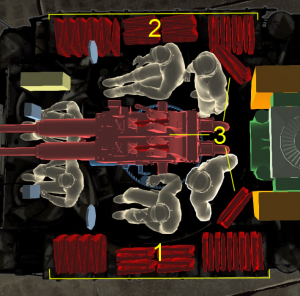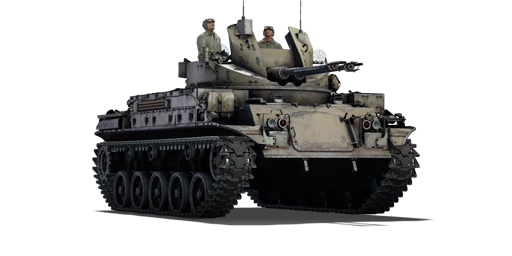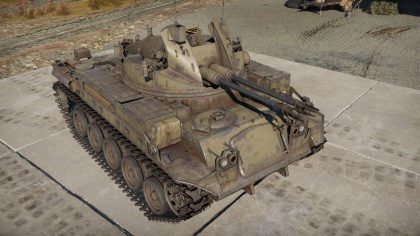M42
Contents
| This page is about the American SPAA M42. For other uses, see M41 (Family). For the Italian SPAA with a similar name, see M42 (Italy). |
Description
The Twin 40 mm Self-Propelled Gun M42 Duster is a rank III American Self-Propelled Anti-Aicraft (SPAA) gun
with a battle rating of 5.0 (AB) and 4.0 (RB/SB). The M42 was released in Update 1.47 "Big Guns". It is currently the third to last tank on the American SPAA line up, preceding the M163 Vulcan and M247 Sergeant York. While armed with the same turret and cannons from its predecessor the M19, it has enhanced mobility by using the chassis of the M41A1 Walker Bulldog light tank.
The U.S. military awarded General Motors Corporation's tank division with a contract to design and build the M42 Duster, as an armoured light air-defence gun platform. Though initially developed to provide defence from air attacks, by the time the Duster was ready to be fielded in mass, the military switched gears determining that the Duster was not a useful tool against the jet aircraft which were beginning to fill the sky.
While Self Propelled Anti-Aircraft (SPAA) vehicles were initially created to counter aircraft, other uses developed in which they saw action against armoured vehicles. Compared to other contemporary SPAA vehicles (ZSU-37, Wirbelwind, Multiple Gun Motor Carriage M13, etc...) though, the M42 is typically regarded as the least effective when used against vehicles with armour protection. The penetration value of the armour-piercing rounds is considered too low to penetrate armour plating, even when not angled. The Duster, however, can be devastating against vehicles with very little to no armour, especially at 120 rounds per minute for each gun.
Being considered a light tank, the M42 does not have the armour capability to stand up directly to many of the other vehicles which it will face on the battlefield, especially against tanks which may fire high-explosive shells. The Duster will fare better against machinegun fire and potentially against some of the lighter autocannon fire which it may encounter, though not for long. Due to the M42's lightweight nature, it is best to stage where there is cover to help shield the Duster. It is also essential to only expose the vehicle when necessary to get a shot. If discovered, it is best to have a contingency location to which to fall back and regroup.
General info
Survivability and armour
Armour type:
- Rolled homogeneous armour
| Armour | Front (Slope angle) | Sides | Rear | Roof |
|---|---|---|---|---|
| Hull | 12.7 mm (33°) Front glacis 25.7 mm (39°) Bottom glacis |
12.7 mm | 12.7 mm Top 19 mm Bottom |
12.7 mm |
| Turret | 12.7 mm | 8 mm | 8 mm | N/A |
Notes:
- Suspension wheels and tracks are 15 mm thick.
Mobility
| Game Mode | Max Speed (km/h) | Weight (tons) | Engine power (horsepower) | Power-to-weight ratio (hp/ton) | |||
|---|---|---|---|---|---|---|---|
| Forward | Reverse | Stock | Upgraded | Stock | Upgraded | ||
| Arcade | 79 | 21 | 22.5 | 710 | 954 | 31.56 | 42.4 |
| Realistic | 73 | 19 | 442 | 500 | 19.64 | 22.22 | |
Armaments
| 40 mm Bofors (x2) | |||||
|---|---|---|---|---|---|
| Capacity (Belt capacity each) | Fire rate (shots/minute) |
Vertical guidance |
Horizontal guidance | ||
| 480 (8) | 120 | -3°/+85° | ±180° | ||
| Turret rotation speed (°/s) | |||||
| Mode | Stock | Upgraded | Prior + Full crew | Prior + Expert qualif. | Prior + Ace qualif. |
| Arcade | 23.8 | 32.9 | 40.0 | 44.2 | 47.0 |
| Realistic | 23.8 | 28.0 | 34.0 | 37.6 | 40.0 |
| Reloading rate (seconds) | |||||
| Stock | Prior + Full crew | Prior + Expert qualif. | Prior + Ace qualif. | ||
| 0.65 | 0.58 | 0.53 | 0.50 | ||
Ammunition
| Penetration statistics | |||||||
|---|---|---|---|---|---|---|---|
| Ammunition | Type of warhead |
Penetration in mm @ 90° | |||||
| 10m | 100m | 500m | 1000m | 1500m | 2000m | ||
| Mk.II | HEFI-T* | 3 | 3 | 3 | 3 | 3 | 3 |
| M81A1 | AP-T | 76 | 74 | 62 | 45 | 33 | 24 |
| Shell details | ||||||||||
|---|---|---|---|---|---|---|---|---|---|---|
| Ammunition | Type of warhead |
Velocity in m/s |
Projectile Mass in kg |
Fuse delay
in m: |
Fuse sensitivity
in mm: |
Explosive Mass in g (TNT equivalent): |
Normalization At 30° from horizontal: |
Ricochet: | ||
| 0% | 50% | 100% | ||||||||
| Mk.II | HEFI-T* | 874 | 0.86 | 0.2 | 0.1 | 63 | +0° | 79° | 80° | 81° |
| M81A1 | AP-T | 874 | 0.88 | N/A | N/A | N/A | -1° | 47° | 60° | 65° |
Belt types
| Belts | Shell composition | Combat usage |
| Default | AP-T / HEFI-T* | These work fine, a hit on an aircraft means instant disassembly for it and still is able to hurt ground vehicles, especially if it is side into the side of a enemy tank. These seem like a good I don't know what i will run into belt. |
| Mk.II | HEFI-T* | These mean bad news for aircraft, what should be used for AA work. |
| M81A1 | AP-T | These are the worst belts against airplanes. however, they are able to hurt ground vehicles especially if it is side into the side of a enemy tank. If you plan on penetrating tanks, load this and flank, since side shots are almost a necessity. |
Ammo racks

| Full ammo |
1st rack empty |
2nd rack empty |
3rd rack empty |
4th rack empty |
Recommendations | Visual discrepancy |
|---|---|---|---|---|---|---|
| 60 | 50 (+10) | 38 (+22) | 14 (+46) | 2 (+58) | Keep Full | Yes |
Usage in the battles
This tank has no armour, but a lot of speed and guns that do nothing against anything with actual armour. Refrain from attacking enemies that can take a hit from you, though you can roam around the battlefield with your insane speed and act as a scout. Ironically, shooting enemies you know your shot will bounce off of makes sense if you look at it as it then makes the enemy vehicle show up on the mini-map for all players to see, although it will also expose you. However, you could stay with your teammates and shoot down planes that will be harassing them. They know the danger of the Bofors guns but for some pilots that is a gamble, they are willing to take. A good way to lure planes toward you is the act like you don't see them, shoot off at some distant (ground) target, at which the plane will notice you are "distracted" and as they begin to dive to attack you, quickly re-aim the cannons and fire.
Modules
| Tier | Mobility | Protection | Firepower | ||
|---|---|---|---|---|---|
| I | Tracks | Parts | Mk.II | Horizontal Drive | |
| II | Suspension | Brake System | FPE | M81A1 | Adjustment of Fire |
| III | Filters | Crew Replenishment | Elevation Mechanism | ||
| IV | Transmission | Engine | Artillery Support | NVD | |
Pros and cons
Pros:
- 40 mm cannons are devastating to planes
- AP rounds able to penetrate roughly 60 mm can be used against most medium tank side armour it could face
- Unsynchronized firing helps improve overall fire rate to double that list
- Outside from default belts, the other belt options are made of a single type of shell that can be relied on
- Relatively fast vehicle with good mobility due to the M41A1 light tank basis
- Fast turret traverse rate helps track aircraft
- Improved mobility, protection and ammunition count compared to M19.
Cons:
- Despite 40 mm cannons and the unsynchronized firing, the overall fire rate is still lower than its contemporaries
- 40 mm AP rounds are not the best AP rounds to use overall due to relatively low penetration
- Open turret allows aerial attacks and machine guns to decimate the exposed crew
- Very thin armour hull
- Is hull-breakable
- Careless driving can damage the vehicle
- Ammo can be used up rather quickly due to the dual-gun firing, prolonged combat can find the ammo stowage run empty
- Easily ammo-racked due to racks scattered all around the turret, aerial autocannons could set it off if hit
History
Development
During late World War II and the Korean War, the US Army were using the Twin Gun Motor Carriage M19 as their main armoured forces anti-aircraft gun. However, during the Korean War, the US Army decides to phase out their M24 Chaffees and its variants, M19 included, in order to implement newer designs made in the time period. One of these newer designs was the development of the M41 Walker Bulldog light tank. The 40 mm armament on the M19 was deemed effective enough to continue usage past the M19, so the turret of the M19 with the twin 40 mm cannons was taken off the chassis and modified to fit the chassis of the M41 light tank, which had a larger turret ring than the M24 Chaffee. This instalment of the anti-aircraft armament onto the M41 light tank was designated as the M42. The production of the vehicle began in early 1952 at the General Motors Cleveland Tank Plant and entered service in 1953, replacing the many other self-propelled anti-aircraft vehicles the army was fielding. Production continued from 1952 to December 1959, ending with a total number of 3,700 units. During the production, the M42 was upgraded in 1956 with a new engine and other upgrades common with the M41 light tank, this upgraded variant was the M42A1.
Combat usage
The M42 was kept in US inventory past the Korean War, however, it was sometime between then and the 1960s that the US Army came to the conclusion that ordinary anti-aircraft guns are unable to engage the new aircraft age of jets. Thus, the M42 was to be retired in 1963 and replaced by the HAWK surface-to-air missile. Though, even after their retirement, the units stationed at the Panama Canal Zone kept their M42s until the 1970s.
Then in the 1960s, with the intensity of the Vietnam War brewing up, more American soldiers get stationed in the country. Experiences with the missile showed that the HAWK missile system suppose to engage the new jet planes performed badly in low-altitude defence. In order to ensure a tight grip on the airspace, the Army began to reissue the M42s to the Army in the air defence artillery battalions which contain four M42 batteries and one headquarters battery. These M42s start arriving in the fall of 1966 in three battalions, 1/44th, 5/2nd, and the 4/60th Battalions. Though, despite their role, no dire air threat was presented from the North Vietnamese to the South, so the M42s were relegated to ground support duties in a tradition shared by its past predecessors. The M42s in this role was deployed as on-point security, convoy escorts, or a perimeter defence; it was in these roles that the M42 earned its nickname "Duster" for its lethality and effectiveness in ground support roles against the infantry.
After Vietnam, the M42 Dusters-equipped battalions were deactivated in late December 1971. These Dusters still in Vietnam were given to the ARVN forces. Training dusters at Fort Bliss were given back to the National Guard it was originally issued to, and multiple National Guard units were stationed with the M42 until it was officially retired in 1988, with the last unit retiring it be 2nd Battalion, 263 Air Defense Artillery.
In-game description
The M42 self-propelled 40mm anti-air mount built by General Motors (GM). It was based on the M41 light tank and was intended to replace the M19 self-propelled anti-air mount. The unofficial name “Duster” was also used for this installation. A total of 3,700 M42’s were produced between 1951 and 1959.
Media
Skins and camouflages for the M42 Duster from live.warthunder.com.
Read also
[Devblog] La-5FN and M42 Duster
Sources
Paste links to sources and external resources, such as:
- topic on the official game forum;
- other literature.
| USA anti-aircraft vehicles | |
|---|---|
| M3 Half-track derivatives | M13 MGMC · M15 CGMC · M16 MGMC |
| M24 derivative | M19A1 |
| M41 derivative | M42 |
| Radar SPAAG | M163 · M247 |
| Missile SPAA | ADATS · Imp.Chaparral · LAV-AD · XM975 |





